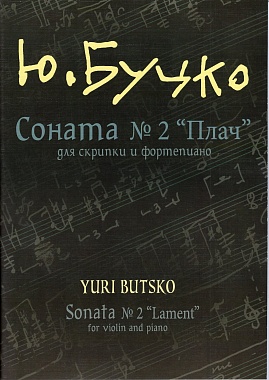The previously unpublished Violin Sonata No. 2 by Yuri Butsko (1981) has two versions: a "chamber" one, accompanied by a piano, and a "concert" one, that utilises the entire orchestra. The composer himself called his two violin sonatas, along with Sonata No. 2 for a cello with a piano (or with an orchestra), “Grand Sonatas”. He thought of them as a kind of a sequence. All the Grand Sonatas have subheadings indicating a certain general theme. For example, the Cello Concerto is called “Ricercar”, and the Second Violin Concerto is named “Lament”. The First Violin Sonata, in its orchestral version, has the subheading "Epitaph"; the meaning of which is revealed by the dedication of the work to the memory of Maxim Ivanovich Zalessky. The Second Violin Concerto and the Second Violin Sonata are dedicated to the memory of his sister, Fomaida Ivanovna Zalesskaya.
Both of them belonged to a family of Kargopol peasants, the Old Believers, whom the composer met in his youth during various wanderings in northern Russia. This is what Butsko said about the Zalessky siblings in an interview some time later: ''Life brought me together with people whom I then came to visit every year, and the year in which I did not come to them in the Arkhangelsk region was empty for me. They were the Old Believers who gave me everything - the book, Znamenny Chant, and life itself. And I still write essays dedicated to the memory of these people. I still talk to them."
The Zalesskys knew the Old Russian singing tradition inside and out and could sing hooked notation chants beautifully. Maxim Ivanovich was also an outstanding collector of Old Russian and Old Believers' writings; some valuable books from his personal collection are now kept within some of the largest public collections in Russia. Fomaida Ivanovna was a remarkable singer, connoisseur of ancient hook writings and a professional scribe.
The Second Violin Sonata consists of a very long part which, in fact, grows from the short thematic seeds planted at the beginning. It unfolds slowly and without very sharp contrasts, more like a single canvas. The development in the sonata can be likened to a curved line where, at the top of the gradually achieved dynamic and semantic rise, there are two extensive cadenzas: a piano one and a violin one. Afterwards, the movement goes in the opposite direction, to the first motives of the piece, representing a liberally modified recapitulation of the initial section.
Initial intonation seeds seem to return to their origins and on the verge of their disappearance a new quality appears - the theme of the Demestvenny Chant of Psalm 136 "On the Rivers of Babylon". Its appearance is also not abrupt or defiant, seemingly it floats out of the silence, being woven into a network of voices singing to the melody. Here, at the very end, the concentrated, ascetic, often austere musical tissue is illuminated by a soft warm light.
Music Set Ilya Kononov
Technical Editor Evgeniya Voronova
ISMN 979-0-706450-23-0
Edition number 12212



